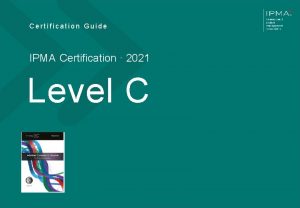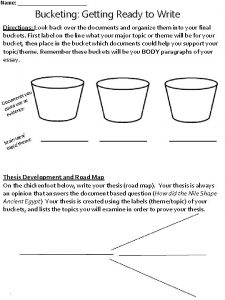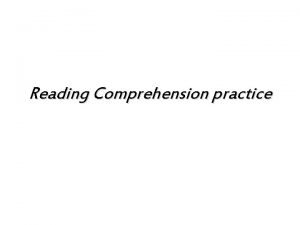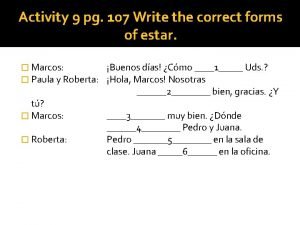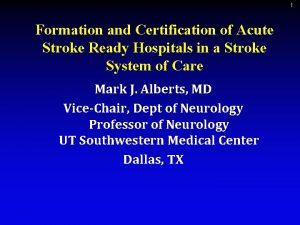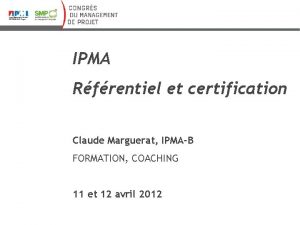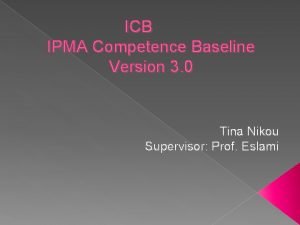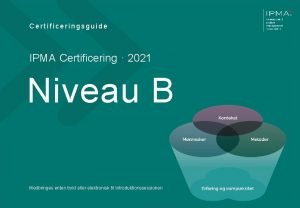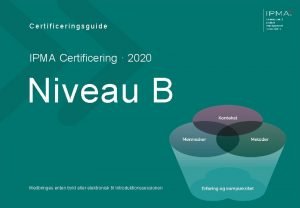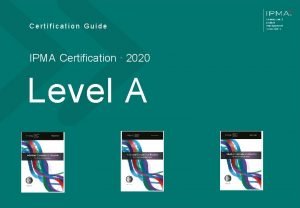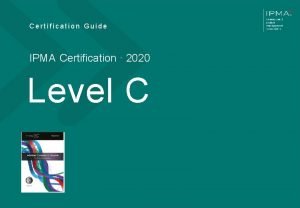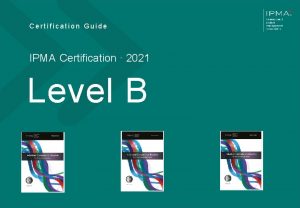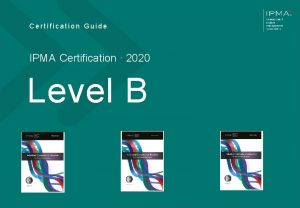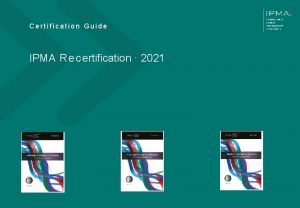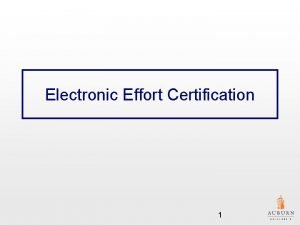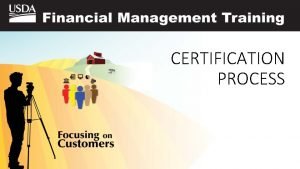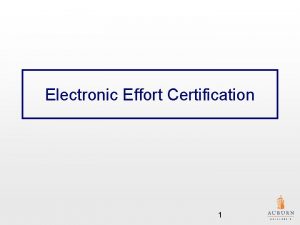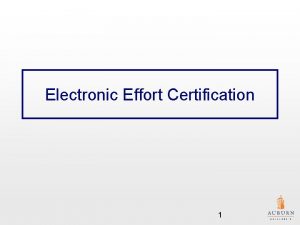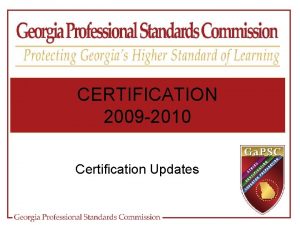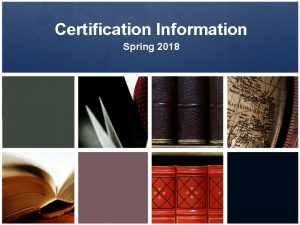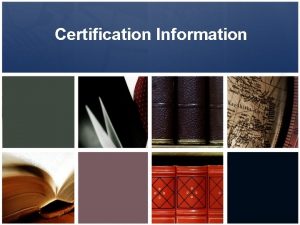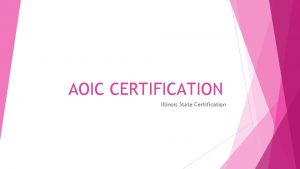Getting Ready for IPMA Level D Certification in



































- Slides: 35

Getting Ready for IPMA Level D® Certification in the USA 1. 5. 1

Presentation Overview v The Level D Exam: ■ The IPMA ICB (Individual Competence Baseline) ■ Sample questions and scoring v Completing your application: ■ Application form ■ Self-assessment form 3

The IPMA ICB (Individual Competence Baseline) The ICB provides the primary basis for the Level D assessment. MOVING 1

Module Overview Ø IPMA standards Ø Structure of the ICB Ø Competence elements Ø Key competence indicators (KCIs) 5

IPMA Standards 6

Structure of the ICB v Thirty Competence Elements (CEs): ■ Perspective ■ Personal ■ Practice v Three Domains: ■ Project Management ■ Program Management ■ Portfolio Management 7

28 CEs Assessed at Level D v Perspective: ■ Strategy ■ Governance, structures and processes ■ Compliance, standards and regulations ■ Power and interest ■ Culture and values v Personal: ■ Self-reflection and self■ ■ ■ ■ ■ management Personal integrity and reliability Personal communication Relations and engagement Leadership Teamwork Conflict and crisis Resourcefulness Negotiation Results orientation 8

… continued v Practice: ■ Project design ■ Requirements and objectives ■ Scope ■ Time ■ Organization and information ■ Quality ■ Finance ■ Resources ■ Procurement ■ Plan and control ■ Risk and opportunity ■ Stakeholders ■ Change and transformation 9

Sample CE Definition Risk and opportunity includes the identification, assessment, response planning and implementation, and control of risks and opportunities in projects. Risk and opportunity management helps decision makers make informed choices, prioritize actions, and distinguish among alternative courses of action. Risk and opportunity management is an ongoing process taking place throughout the project. 10

Competence Indicators ◉ Develop and implement a risk management framework ◉ Identify risks and opportunities ◉ Assess the probability and impact of risks and opportunities ◉ Select strategies and implement response plans to address risks and opportunities ◉ Evaluate and monitor risks, opportunities, and implemented responses 11

Sample Questions and Scoring Multiple-choice questions Short-essay questions MOVING 2

Two Parts v 60 multiple-choice questions in 50 minutes: ■ Could address any competence element ■ Four options and one right answer v 10 short-essay questions in 120 minutes: ■ Could address any competence element v All 28 competence elements addressed by at least one question 13

MC Question Design v One, and only one, right answer v Key words (not, least, except) underlined v Correct answers balanced (usually 12 -18 of each) v All questions conform to best practices: ■ No excess text ■ No trick questions ■ No obscure references 14

Sample Multiple-Choice Question Cost and schedule risk can be directly mitigated through the use of: a. simulations. b. decision trees. c. reserves. d. status reports. 15

Explanation for Correct Answer v Directly is the key word in the question stem, so it is underlined. v Options a, b, and d may all be used in project risk management, but none would directly mitigate any identified risk. 16

Sample Short-Essay Question Draw and label a probability-impact matrix. Describe how it is used. Scoring Guidance Max Pts. Drawing: probability on one axis 2 Drawing: impact (or effect) on the other axis 2 Drawing: at least 3 columns and at least 3 rows 1 Description: estimate/evaluate probability and impact 4 Description: place risks in correct cell 4 Description: use to prioritize risks 7 Total 20 17

Short-Essay Discussion v Scoring guidance ensures consistency in marking v 0– 20 points for each question v Grammar and punctuation are not scored 18

Passing Score v Passing score is 70%: ■ Multiple-choice section is worth maximum 50 points ■ Short-essay section is worth maximum 200 points ■ Short-essay section is weighted 0. 75 ■ Total score of 140 required to pass 19

Summary of Key Points 20

Application Form Six sections. Simple and straightforward. MOVING 3

Application Sections 1. Overview 2. Assurances and releases 3. Personal information 4. Exam and interview choices 5. Required supporting information 6. Payment and signature 22

Start your application by checking the box for Level D. If you think you might be eligible for a higher level, contact IPMA-USA for advice before submitting your 23

The General Information section has links to all the documents you will need. Your assessment must be completed within 18 months. 24

All assurances must be marked “yes” or your application will be rejected. Releases are your choice. 25

This information should all be self-explanatory. Starred fields are required. 26

Provide professional references, not personal references. References must be familiar with your work. References are normally contacted via email with a link to an online survey. 27

Section 4 is for individual applicants only. Individuals applicants must provide 3 options. 28

This section documents the additional items that must be submitted along with your application. 29

Check the boxes as indicated; sign and date your application. 30

Self-Assessment Form What do you see as your strengths and weaknesses? MOVING 4

Overview Ø Structure — competence elements by group Ø Purpose — get you familiar with the ICB Ø Why you should care — self-assessment may alert you to weaknesses before you sit for your exam 32

First page has General Information and Instructions. Contact IPMA-USA if you have questions or problems. 33

Scoring instructions are repeated in lavender block: S = strengths; W = weaknesses Identify 6 -8 strengths and 6 -8 weaknesses. 34

As you enter your scores, the Overall sections will display your current totals. There is one Overall section at the top of the worksheet and another at the bottom. 35

Contact: Cert-Operations@IPMA-USA. org with questions or suggestions. 36
 Stay ready so you don't have to get ready
Stay ready so you don't have to get ready Ipma certification exam
Ipma certification exam Ipma level d exam
Ipma level d exam The secret of getting ahead is getting started
The secret of getting ahead is getting started Bucketing getting ready to write
Bucketing getting ready to write I was getting ready for sam's birthday
I was getting ready for sam's birthday Getting ready to cook
Getting ready to cook Getting ready to cook
Getting ready to cook For adult
For adult Getting ready for the real world answers
Getting ready for the real world answers Marta and berta are getting ready for school
Marta and berta are getting ready for school Ipma level d selbststudium
Ipma level d selbststudium Zoom meeting teilnehmerliste exportieren
Zoom meeting teilnehmerliste exportieren Acute stroke ready certification
Acute stroke ready certification Claude marguerat
Claude marguerat Icb ipma competence baseline
Icb ipma competence baseline Ipma
Ipma Ipma certificering pris
Ipma certificering pris Ipma self assessment
Ipma self assessment Ipma certificering
Ipma certificering Ipma certificering
Ipma certificering Document answers
Document answers Ncic restricted files
Ncic restricted files Women's ministries leadership certification program level 2
Women's ministries leadership certification program level 2 Fspos
Fspos Novell typiska drag
Novell typiska drag Nationell inriktning för artificiell intelligens
Nationell inriktning för artificiell intelligens Ekologiskt fotavtryck
Ekologiskt fotavtryck Varför kallas perioden 1918-1939 för mellankrigstiden
Varför kallas perioden 1918-1939 för mellankrigstiden En lathund för arbete med kontinuitetshantering
En lathund för arbete med kontinuitetshantering Personalliggare bygg undantag
Personalliggare bygg undantag Tidbok för yrkesförare
Tidbok för yrkesförare A gastrica
A gastrica Förklara densitet för barn
Förklara densitet för barn Datorkunskap för nybörjare
Datorkunskap för nybörjare Boverket ka
Boverket ka

